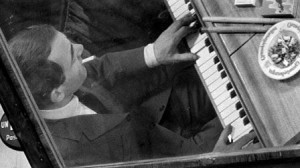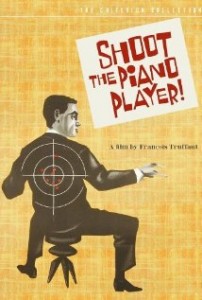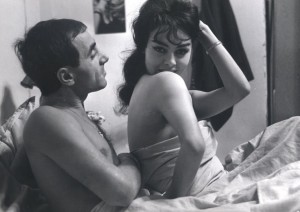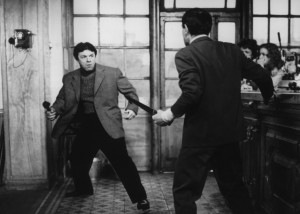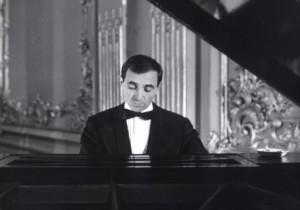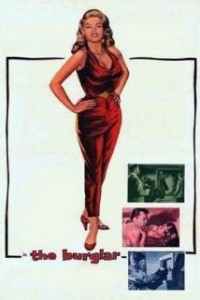Shoot the Pianist [Tirez sur le Pianist] **** (1960, Charles Aznavour, Marie Dubois, Nicole Berger, Michèle Mercier, Albert Rémy, Serge Davri, Claude Mansard, Daniel Boulanger) – Classic Movie Review 93
François Truffaut turns David Goodis’s thriller novel Down There into an exuberant, quirky, stylish personal take on the Hollywood B-movie thriller for his second feature, the 1960 film Tirez sur le Pianist [Shoot the Pianist].
For his second feature, the 1960 film Tirez sur le Pianist [Shoot the Pianist], François Truffaut turns David Goodis’s 1956 American potboiler thriller novel Down There into an exuberant, quirky, stylish personal take on the Hollywood B-movie thriller in the provocative fashion of the Sixties French New Wave (Nouvelle Vague).
Gallic chanteur Charles Aznavour is ideal as Charlie Kohler, the melancholic piano player working in a sleazy Parisian bistrot bar, run by the unstable, jealous and devious Plyne (Serge Davri). That’s where his older gangster brothers Chico and Richard (played by Albert Remy and Jean-Jacques Aslanian) hang out, and also where Léna (Marie Dubois) is the tough waitress. Léna knows Charlie’s true identity as concert pianist Édouard Saroyan, whose wife Thérèse had committed suicide.
Charlie spends his nights with prostitute Clarisse (Michèle Mercier) when she has no clients, and she cooks for his little brother Fido (Richard Kanayan). Léna is in love with Kohler and they become an item. But trouble starts when they are threatened by a couple of comically dangerous gangsters, Momo and Ernest (Claude Mansard and Daniel Boulanger), who first abduct Charlie and Léna, and later abduct Fido. The two older brothers have stolen the gangsters’ loot.
After the big success of Truffaut’s realist Les Quatre Cents Coups (The 400 Blows) in 1959, this is a very different kind of film and was not a hit or much admired in its day. And yet it is one of Truffaut’s best movies, taut, amusing and unsettling. Georges Delerue’s jazzy score is superb, arguably even more impressive than Raoul Coutard’s outstanding cinematography in gleaming black and white. But then some of Coutard’s images are astonishing, especially at the snowscape finale at the brothers’ mountain hideout.
It is shot in the widescreen process Dyaliscope, which Truffaut described as being ‘like an aquarium that allows the actors to move around the frame more naturally’, and this he manages with style. Truffaut wanted to make it as a big-budget film, but no studio offered the finance, so the film was made on the Paris streets, and this is the main key to its success.
Tirez Sur Le Pianiste (aka Shoot the Pianist or Shoot the Piano Player!) might seem minor Truffaut now, but it is still major anyone else.
The last word on it should go to Truffaut, who commented: ‘In Goodis I like a lot of things: characters, action, also the way it’s written. I remember I wanted to do this book because I admired it.’ Fair enough. Nevertheless, Tirez Sur Le Pianiste is no attempt to film the novel or provide a cinematic equivalent of it, It is an entirely different thing, not really a thriller at all, just like Godard’s Breathless and Alphaville aren’t. It is more a character study, a sombre noir take on life, and a playful musing on the vagaries of love and death. Truffaut is showing off in French New Wave style, and he’s got a lot to show and a lot to entertain with. But some of it seems a bit silly and forced. Some of his jokes are weak and some of his tricks are obvious. Hitchcock had a much better way of mixing comedy with crime and murder. That lightness of touch slightly evades the much less playful Truffaut.
Truffaut stated that the theme of the film is ‘love and the relations between men and women’ and that ‘the idea was to make a film without a subject, to express all I wanted to say about glory, success, downfall, failure, women and love by means of a detective story. It’s a grab bag.’ While filming, Truffaut realised he didn’t like gangsters and tried to make them more and more comical, and this has very iffy results.
Truffaut started with two ideas: he wanted to film Goodis’s book and wanted to make a film with Charles Aznavour as star. He got his producer to option both. Then he realised Aznavour wasn’t right as Goodis’s tough hero, so he changed the character into sad and sensitive, and changed the female characters into the strong and dynamic.
And what about Charles Aznavour’s casting? Yes, he is is ideal as the melancholic piano player, and failed concert pianist, constantly lost in love, but it’s harder to accept him as a member of a family of small-time gangsters. Nevertheless, even with his slight physique and odd looks, he holds the screen with considerable fascination. It’s more of an iconic star appearance than a rounded acting performance, but that’s obviously what Truffaut wants, and uses well. Aznavour is oddly appealing and sympathetic in an oddball, offbeat sort of way.
The female characters are strong: Marie Dubois as Léna, Nicole Berger as Thérèse Saroyan and Michèle Mercier as Clarisse are all ideal, without doubt appealing and sympathetic. Truffaut himself was The Man Who Loved Women.
Filming took place from 30 November 1959 to 22 January 1960 with re-shoots for two weeks in March. Locations included the A la Bonne Franquette café on the Rue Mussard in Levallois, Le Sappey-en-Chartreuse, around Grenoble and throughout Paris.
Pierre Braunberger didn’t like Boby Lapointe’s songs, saying he couldn’t understand what Lapointe was saying, which prompted Truffaut to add subtitles with a bouncing ball for ‘Framboise’. This is one of the more contrived, sillier jokes, but, like several others in the film, it just about kind of works.
Truffaut began writing the script with Marcel Moussy, co-writer on The 400 Blows. But with Truffaut wanting to keep the film loose and abstract, Moussy quit after a few weeks, and Truffaut wrote the script himself. It changed constantly during shooting. Truffaut recalled: ‘I wanted to break with the linear narrative and make a film where all the scenes would please me’.
It was mainly French film-makers who were interested in Goodis’s work but his novels were occasionally adapted by Hollywood:
David Goodis wrote the screenplay of director Paul Wendkos’s 1957 US film The Burglar from his own novel. Goodis’s novel was filmed again in France in 1971 as Le Casse, aka The Burglars, in 1971 with Jean-Paul Belmondo, Omar Sharif and Dyan Cannon.
Goodis co-wrote the screenplay of director Vincent Sherman’s US film The Unfaithful (1947).
Dark Passage is a 1947 American mystery thriller film directed by Delmer Daves, starring Humphrey Bogart and Lauren Bacall, and based on the 1946 novel by David Goodis.
Nightfall is a 1956 American crime film noir directed by Jacques Tourneur and starring Aldo Ray, Brian Keith and Anne Bancroft, based on a 1948 novel by David Goodis.
The cast are Charles Aznavour as Charlie Koller / Edouard Saroyan, Marie Dubois as Léna, Nicole Berger as Thérèse Saroyan, Michèle Mercier as Clarisse, Serge Davri as Plyne, Claude Mansard as Momo, Richard Kanayan as Fido Saroyan, Albert Rémy as Chico Saroyan, Jean-Jacques Aslanian as Richard Saroyan, Daniel Boulanger as Ernest, Claude Heymann as Lars Schmeel, Alex Joffé as Passerby, Boby Lapointe as The Singer, and Catherine Lutz as Mammy.
© Derek Winnert 2013 Classic Movie Review 93
Check out more reviews on http://derekwinnert.com/
http://derekwinnert.com/jules-et-jim-classic-film-review-290/
http://derekwinnert.com/les-quatre-cents-coups-classic-film-review-61/

